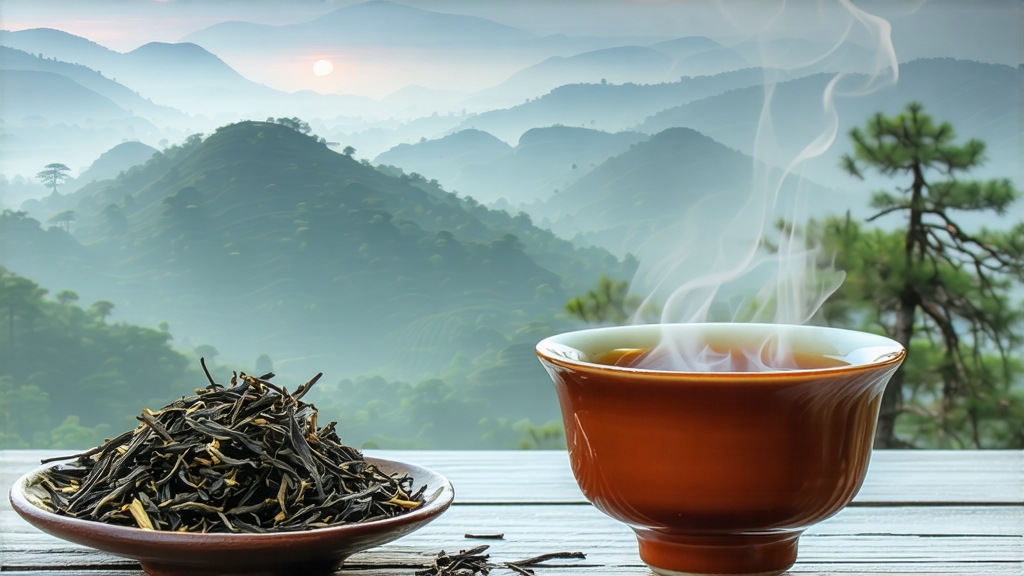
Long before English merchants coined the word “black tea,” Chinese mountain folk were already charcoal-drying leaves over resinous pine in the Wuyi massif of northern Fujian. The tea they created—Lapsang Souchong—became the first fully oxidised leaf ever exported, sailed around the Cape of Good Hope, and filled the porcelain cups of Stuart London. Today it remains the most polarising yet historically pivotal of China’s red teas: a sip that can evoke campfire nostalgia or, in its unsmoked modern form, pure mountain honey. Understanding Lapsang Souchong is therefore a gateway to both the genealogy of world black tea and the evolving palate of contemporary connoisseurs.
Origin and myth
The name itself is a cartographic riddle. “Souchong” refers to the fourth and fifth leaves down the stem—larger, tougher material once deemed too coarse for green-tea tribute yet perfect for the newfangled oxidation process. “Lapsang” is the Cantonese pronunciation of “Zheng Shan,” meaning “original mountain,” a protected core zone inside the 60-km² Wuyi National Nature Reserve where altitudes climb from 600 m to 1 500 m, humidity lingers at 80 %, and a micro-climate of short, mild days and long, cool nights slows leaf growth to a crawl. Local legend credits the birth of smoking to a Qing-era army unit that commandeered a tea factory during the busy spring season; in haste to dry the leaves before they spoiled, workers spread them over fresh pine embers, inadvertently creating the aromatic leaf that Dutch traders would soon re-label “Bohea.” Whether apocryphal or not, the story underlines a key truth: necessity, geography and pine forests forged a style that could not be replicated elsewhere.
Terroir and cultivar
Within the reserve only a handful of villages—Tongmu, Guadun, Miaowan—possess the right convergence of rocky, well-drained tuff soil, mineral-rich spring water and drifting mists that moderate ultraviolet exposure. The indigenous cultivar is Xiao Ye Zhong (“small-leaf species”), a shrub whose thick cuticle and low catechin content translate into malt sweetness rather than brisk astringency after oxidation. Because the reserve is strictly protected, no new tea gardens have been planted since 1998; every kilo of authentic Zheng Shan Xiao Zhong therefore comes from old-growth bushes or seed-propagated descendants interplanted with towering Masson pines and bamboo. This biodiversity is not scenic backdrop—it is the source of the resinous air that the leaf quietly inhales while withering.
Traditional craft: the pine-smoke choreography
Although modern tea science describes black tea as “fully oxidised,” Lapsang Souchong is better understood as a four-act play in which smoke is both stage and actor.
Act I: Outdoor withering
Fresh leaves are laid on bamboo mats in open-walled sheds from 6 p.m. to 9 a.m., absorbing cool mountain air and the volatiles released by smouldering pine logs in the central trench. Moisture drops from 75 % to 60 %, but more importantly the leaf begins to adsorb guaiacol and syringol, the phenols responsible for the tea’s signature campfire note.
Act II: Rolling and oxidation
Once the leaves feel leathery, they are machine-rolled for 45 minutes to rupture cells and initiate oxidation. Instead of moving to a conventional oxidation chamber, the leaf is piled into cedar-lined wooden crates nested above slow-burning pine embers. Heat (28 °C) and aromatic smoke accelerate enzymic browning while simultaneously fixing the smoky signature deep inside the leaf matrix.
Act III: Red-firing (Hong Bei)
The most critical and closely guarded step. A wood-fired brick oven is heated to 80 °C; a thin layer of leaf is spread on bamboo trays slid into the oven mouth for three minutes, then quickly removed and tossed to dissipate residual heat. This shock-firing halts oxidation, reduces moisture to 7 % and caramelises surface sugars, creating the glossy, chocolate-brown strip that unfurls later into an amber liquor.
Act IV: Final smoking
After sorting and sieving, the finished tea is gently smoked once more for 30 minutes over embers of 40-year-old Masson pine heartwood. Master smokers judge readiness by ear: when the crackle of resin subs